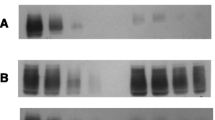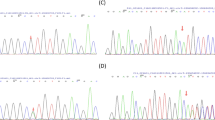Summary
Six individuals with complete deficiency of erythrocyte AMP deaminase have been discovered. They are all healthy and have no hematological disorders. The deficiency is only in isozyme E, which is the erythrocyte type isozyme, and is inherited as an autosomal recessive trait. The frequency of the mutant gene is surprisingly high, one heterozygote in about 30 of the population in Japan, Seoul, and Taipei. The ATP level is approximately 50% higher in AMP-deficient erythrocytes compared to that of control cells. Degradation of adenine nucleotide is slower in the deficient erythrocytes than in the control erythrocytes.
Similar content being viewed by others
References
Askari A, Rao SN (1968) Regulation of AMP deaminase by 2,3-diphosphoglyceric acid: a possible mechanism for the control of adenine nucleotide metabolism in human erythrocytes. Biochim Biophys Acta 151:198–203
Bergmeyer HU, Gawehn K, Grassl M (1974) Enzymes as biochemical reagents. In: Bergmeyer HU (ed) Methods of enzymatic analysis. Academic Press, New York London, pp 425–522
Bougusky RT, Lowenstein LM, Lowenstein JM (1976) The purine nucleotide cycle. A pathway for ammonia production in the kidney. J Clin Invest 58:326–335
Chapman AG, Atkinson DE (1973) Stabilization of adenylate energy charge by the adenylate deaminase reaction. J Biol Chem 248: 8309–8312
Coffee CJ, Solano C (1977) Rat muscle 5′-adenylic acid aminohydrolase — role of K+ and adenylate energy charge in expression of kinetic and regulatory properties. J Biol Chem 252:1606–1612
Cunningham B, Lowenstein JM (1965) Regulation of adenylate deaminase by adenosine triphosphate. Biochim Biophys Acta 96: 535–537
Fishbein WN, Arumbrustmacher VW, Griffin JL (1978) Myoadenylate deaminase deficiency — a new muscle disease. Science 200:545–548
Hershfield MS, Snyder FF, Seegmiller JE (1977) Adenine and adenosine are toxic to human lymphoblast mutant defective in purine salvage enzyme. Science 197:1284–1287
Lamprecht W, Trautschold I (1974) Adenosine-5′-triphosphate determination with hexokinase and glucose-6-phosphate dehydrogenase. In: Bergmeyer HU (ed) Methods of enzymatic analysis. Academic Press, New York London, pp 2101–2110
Lowenstein JM, Tornheim K (1971) Ammonia production in muscle: the purine nucleotide cycle. Science 171:397–400
Michal G (1974) d-Glycerate-2,3-diphosphate. In: Bergmeyer HU (ed) Methods of enzymatic analysis. Academic Press, New York London, pp 1433–1438
Moss KM, McGivan JD (1975) Characteristics of aspartate deamination by the purine nucleotide cycle in the cytosol fraction of rat liver. Biochem J 150:275–283
Ogasawara N, Goto H, Yamada Y, Watanabe T (1978) Distribution of AMP-deaminase isozyme in rat tissues. Eur J Biochem 87:297–304
Ogasawara N, Goto H, Yamada Y, Watanabe T, Asano T (1982) AMP deaminase isozymes in human tissues. Biochim Biophys Acta 714:298–306
Ogasawara N, Goto H, Yamada Y, Nishigaki I, Itoh T, Hasegawa I (1984a) Complete deficiency of AMP deaminase in human erythrocytes. Biochem Biophys Res Commun 122:1344
Ogasawara N, Goto H, Yamada Y, Watanabe T (1984b) Distribution of AMP deaminase isozymes in various human blood cells. Int J Biochem 16:269–273
Randerath K, Randerath E (1967) Thin-layer separation methods for nucleic acid derivatives. Methods Enzymol 12:323–347
Sabina RL, Swain JL, Patten BM, Ashizawa T, O'Brien WE, Holmes EW (1980) Disruption of the purine nucleotide cycle: a potential explanation for muscle dysfunction in myoadenylate deaminase deficiency. J Clin Invest 66:1419–1423
Sabina RL, Swain JL, Olanow CW, Bradley WG, Fishbein WN, DiMauro S, Holmes EW (1984) Myoadenylate deaminase deficiency: functional and metabolic abnormalities associated with disruption of the purine nucleotide cycle. J Clin Invest 73:720–730
Schultz V, Lowenstein JM (1976) Purine nucleotide cycle: evidence for the occurrence of the cycle in brain. J Biol Chem 251:485–492
Setlow B, Lowenstein JM (1967) Adenylate deaminase. II. Purification and some regulatory properties of the enzyme from calf brain. J Biol Chem 242:607–615
Setlow B, Burger R, Lowenstein JM (1966) Adenylate deaminase. I. The effects of adenosine and guanosine triphosphates on activity and the organ distribution of the regulated enzyme. J Biol Chem 241:1244–1245
Tornheim K, Lowenstein JM (1975) The purine nucleotide cycle: control of phosphofructokinase and glycolytic oscillations in muscle extracts. J Biol Chem 250:6304–6314
Yamada Y, Goto H, Ogasawara N (1981) Adenosine kinase from human liver. Biochim Biophys Acta 660:36–43
Author information
Authors and Affiliations
Rights and permissions
About this article
Cite this article
Ogasawara, N., Goto, H., Yamada, Y. et al. Deficiency of AMP deaminase in erythrocytes. Hum Genet 75, 15–18 (1987). https://doi.org/10.1007/BF00273831
Received:
Issue Date:
DOI: https://doi.org/10.1007/BF00273831




